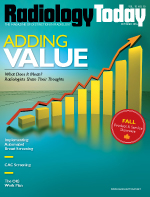 October 2014
October 2014
Guest Commentary: Staff Scheduling — 20th Century Habits You Don’t Want in the 21st Century
By Rich Miller
Radiology Today
Vol. 15 No. 10 P. 10
The advent of spreadsheet technology in the 1980s was a tremendous advance at the time, yet no one would consider it cutting-edge technology in 2014. Nevertheless, it is a revered tool in many radiology practices, where it is prized for building staff schedules.
This devotion, upon closer inspection, is due less to the adequacy of spreadsheets for scheduling and more to the lack of understanding that there are better tools for workforce management available in the 21st century. Many radiology practices continue to use outdated approaches to staff scheduling and staff utilization. While a love of tradition may be nice, in the current climate of decreasing reimbursements and increasing costs, being old-fashioned can have a devastating impact on your practice’s bottom line.
To better manage your personnel and related staff costs, here are three 20th century habits your practice should eliminate in this century:
1. Insufficient staffing data: The biggest problem with using spreadsheets to build staff schedules is how difficult they make it to collect staffing data. Staffing costs represent more than 50% of a typical radiology practice’s operating costs. Understanding staffing patterns and what it costs the practice is critical to helping a practice utilize its providers efficiently.
Nowhere is this more important than in overtime. For nurse and technologist staffing, automated scheduling dramatically outperforms spreadsheets. By integrating scheduling, time tracking, and payroll data in real time, practices can accurately forecast and often reduce overtime. Automatically tracking staff hours makes it easier to make informed decisions, such as deciding which staffers to send home early. In contrast, spreadsheets typically are not set up to track who is going into overtime and who has yet to reach their full hours, thereby denying practices vital data for controlling costs.
With powerful built-in reporting tools, automated workforce management software also makes it routine to track and analyze staff utilization on a level most spreadsheets do not achieve. Reports on call distribution, holiday assignments, and, for academic medical centers, academic vs clinical days, are just a sampling of the ways these workforce management tools can help practices gather and decipher staffing data.
2. Paper scheduling: While it is surprising how frequently practices overlook the need to collect and analyze staffing data, it is more surprising how many large practices still use paper scheduling. In these situations, practices build their schedules manually on a spreadsheet, then print them out and post them on a bulletin board or e-mail them to their providers.
As no additional software is required, practices often mistakenly believe they are saving money by using a paper schedule. What they are not seeing, however, are the ways paper scheduling actually adds to their costs.
First and foremost is the time required to build the schedule. As spreadsheets cannot check errors against practice rules and facility policies, the scheduler must keep track of all of them, along with staffing quotas and paid time-off requests. Given the schedules’ complexity, a senior radiologist often must run the process manually. That senior provider’s time adds up, especially since paper scheduling requires more time than automated scheduling. Each minute that a senior provider spends building the schedules is time that they could spend doing reads, seeing patients, or other valuable work for the practice.
Beyond the financial cost, paper scheduling creates delays and staffing confusions that impact patient care. Without an automated system to process swaps and requests for paid time off or academic days, paper schedules must continuously be revised, increasing the chance that some providers will be working from an incorrect schedule. If a provider who is not appropriately certified for the required scan is accidentally scheduled, patient care gets delayed until an appropriate provider can be located.
In addition, large practices that use paper scheduling may not know exactly which providers are available at any given time. However, with automated scheduling tools, practices can track both assigned and unassigned providers, so holes in the schedule can be avoided and administrators can see exactly which providers are available should last-minute changes to the schedule arise.
3. Uncoordinated schedules in multiple locations: In addition to paper scheduling, different divisions within a department often have the bad habit of posting their schedules in different locations. For example, bone imaging may be on one floor and chest imaging on another. While it may seem logical to maintain different schedules for different divisions, the lack of a central automated system to coordinate and distribute schedules creates hassles. Providers in large practices, in particular, can waste an enormous amount of time running from one floor to another just to determine where they will be working in the coming week.
By allowing for highly granular scheduling at the division level and simultaneously coordinating the overall schedule, automated workforce management tools can more efficiently account for the needs of all levels of a practice.
Health care technology in the 21st century goes far beyond the spreadsheet and can make the goal of improving staffing efficiency much more achievable. By gaining access to real-time staffing data, ending paper scheduling, and consolidating multiple schedules, radiology practices can realize tremendous improvements in practice efficiency.
— Rich Miller is cofounder and CEO of OpenTempo, which provides workforce optimization and staff scheduling solutions for health care organizations.

